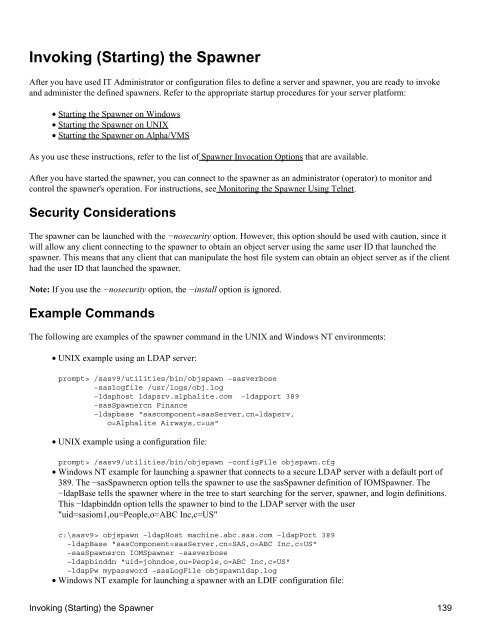SAS® Integration Technologies: Administrator's Guide (LDAP Version)
SAS® Integration Technologies: Administrator's Guide (LDAP Version)
SAS® Integration Technologies: Administrator's Guide (LDAP Version)
You also want an ePaper? Increase the reach of your titles
YUMPU automatically turns print PDFs into web optimized ePapers that Google loves.
Invoking (Starting) the Spawner<br />
After you have used IT Administrator or configuration files to define a server and spawner, you are ready to invoke<br />
and administer the defined spawners. Refer to the appropriate startup procedures for your server platform:<br />
• Starting the Spawner on Windows<br />
• Starting the Spawner on UNIX<br />
• Starting the Spawner on Alpha/VMS<br />
As you use these instructions, refer to the list of Spawner Invocation Options that are available.<br />
After you have started the spawner, you can connect to the spawner as an administrator (operator) to monitor and<br />
control the spawner's operation. For instructions, see Monitoring the Spawner Using Telnet.<br />
Security Considerations<br />
The spawner can be launched with the −nosecurity option. However, this option should be used with caution, since it<br />
will allow any client connecting to the spawner to obtain an object server using the same user ID that launched the<br />
spawner. This means that any client that can manipulate the host file system can obtain an object server as if the client<br />
had the user ID that launched the spawner.<br />
Note: If you use the −nosecurity option, the −install option is ignored.<br />
Example Commands<br />
The following are examples of the spawner command in the UNIX and Windows NT environments:<br />
• UNIX example using an <strong>LDAP</strong> server:<br />
prompt> /sasv9/utilities/bin/objspawn −sasverbose<br />
−saslogfile /usr/logs/obj.log<br />
−ldaphost ldapsrv.alphalite.com −ldapport 389<br />
−sasSpawnercn Finance<br />
−ldapbase "sascomponent=sasServer,cn=ldapsrv,<br />
o=Alphalite Airways,c=us"<br />
• UNIX example using a configuration file:<br />
prompt> /sasv9/utilities/bin/objspawn −configFile objspawn.cfg<br />
• Windows NT example for launching a spawner that connects to a secure <strong>LDAP</strong> server with a default port of<br />
389. The −sasSpawnercn option tells the spawner to use the sasSpawner definition of IOMSpawner. The<br />
−ldapBase tells the spawner where in the tree to start searching for the server, spawner, and login definitions.<br />
This −ldapbinddn option tells the spawner to bind to the <strong>LDAP</strong> server with the user<br />
"uid=sasiom1,ou=People,o=ABC Inc,c=US"<br />
c:\sasv9> objspawn −ldapHost machine.abc.sas.com −ldapPort 389<br />
−ldapBase "sasComponent=sasServer,cn=SAS,o=ABC Inc,c=US"<br />
−sasSpawnercn IOMSpawner −sasverbose<br />
−ldapbinddn "uid=johndoe,ou=People,o=ABC Inc,c=US"<br />
−ldapPw mypassword −sasLogFile objspawnldap.log<br />
• Windows NT example for launching a spawner with an LDIF configuration file:<br />
Invoking (Starting) the Spawner 139
















